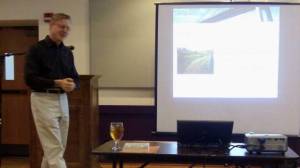Bjorn Billhardt, CEO, founded Enspire Learning Inc. in 2001 so he knows that instructional designers have been guilty of creating boring e-learning programs for a long time. Authors today still fail to use audio-visual features of multimedia-capable PCs, mobile smart phones, and Web 2.0 tools to create interactive personalized learning. In fact, he says its tough dealing with reactions of fellow airline passengers when he introduces himself as an e-learning developer because corporate online training has such a boring reputation. But, he and Enspire Learning have tried from the beginning to change that popular perception with engaging e-learning games and simulations.
Enspire Learning believes the recipe for successful online e-learning consists of three ingredients: Stories, Simulations, and Social Learning. Bjorn explained why these ingredients are effective to Austin ASTD members on November 19, 2010 and with his kind permission I recorded his talk so you may listen to it too.
Three Ingredients and 10 Lessons Learned
To summarize Bjorn’s presentation, successful blended learning developers should include:
- Stories to increase a learner’s motivation and retention (11:00)
- Use simulations to allow learning by “failing” in a safe environment
- Integrate social contacts with fellow learners to put content into context
After ten years developing award-winning e-learning products, Inspire Learning’s success can be summarized in 10 valuable lessons learned (see approximate time in the presentation when discussed.)
- Use visual (not narrative) humor to tell a story. (15:15)
- Use real stories where possible, but don’t be afraid to make details up to fit. (17:48)
- Create meaningful narratives and challenges – boring stories are worse than none at all. (21:15)
- Simulations should give the learner a sense of control and choice. (30:00)
- Forget about sequential instructional design. You can’t design a learning sequence in a simulation. (33:31)
- Most learning occurs in the debrief (after the simulation.) (34:32)
- Tie blended learning elements together, i.e. classroom, online lessons, testing, group activities, etc. (35:22)
- Start with the end in mind, then worry about technology tools. (40:56)
- Create coherent social learning experiences with shared learning moments and accomplishments. (43:50)
- Don’t forget about having fun (as you develop e-learning); it shows whether you cared! (46:05)
Click the play button to listen to Bjorn Billhardt. Duration 50:41 minutes.
Right click on the link below to download the 17.5 MB audio file (mp3)
Using SIMS to Make Online Learning Social
Bjorn also presented at the June, 2010 ASTD national conference and posted his slides on SlideShare. Many of his Austin slides were the same, especially at the beginning.


You must be logged in to post a comment.